University Nursing Care for Clients with Acute Health Problems
VerifiedAdded on 2020/04/07
|24
|4456
|51
Homework Assignment
AI Summary
This document presents a detailed solution to a nursing care assignment, addressing various aspects of patient care in acute health scenarios. The assignment covers critical topics such as maintaining patient confidentiality, ethical considerations in nursing practice, and the role of advocacy. It delves into pre-operative assessments, including risk determination and care planning, as well as the administration of anaesthetic drugs and medications for anxiety reduction. Post-operative care is thoroughly examined, including immediate care plans, medication management (antibiotics, anti-inflammatory, and painkillers), and discharge planning for patients with multiple traumas. The solution also explores potential complications arising from blood transfusions, assessment of patient vital signs, and nursing interventions. The document includes specific case studies and emphasizes the importance of monitoring and addressing potential complications such as pressure ulcers, cardiovascular events, and urinary tract infections. This assignment provides a comprehensive overview of nursing care for clients with acute health problems.
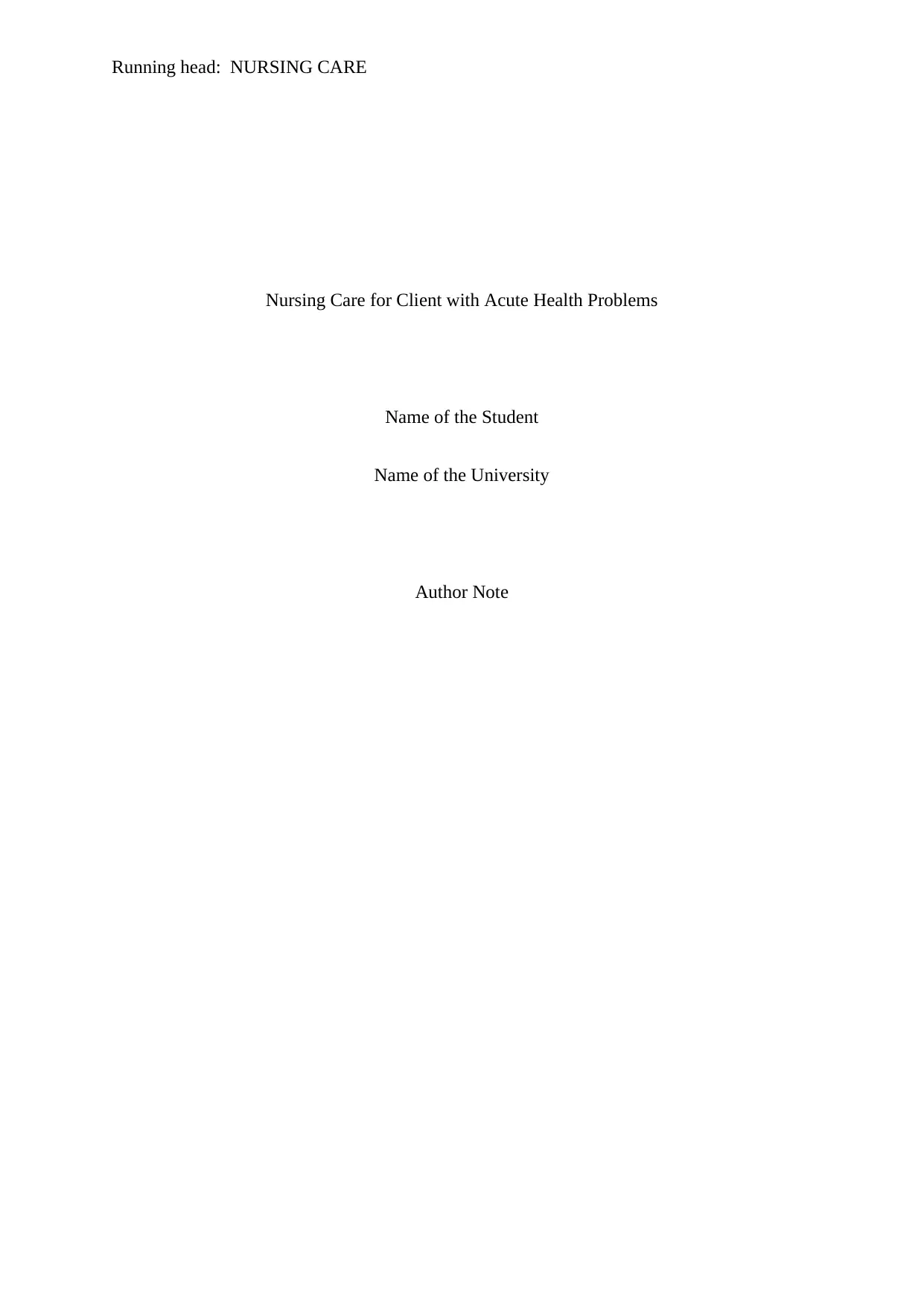
Running head: NURSING CARE
Nursing Care for Client with Acute Health Problems
Name of the Student
Name of the University
Author Note
Nursing Care for Client with Acute Health Problems
Name of the Student
Name of the University
Author Note
Paraphrase This Document
Need a fresh take? Get an instant paraphrase of this document with our AI Paraphraser
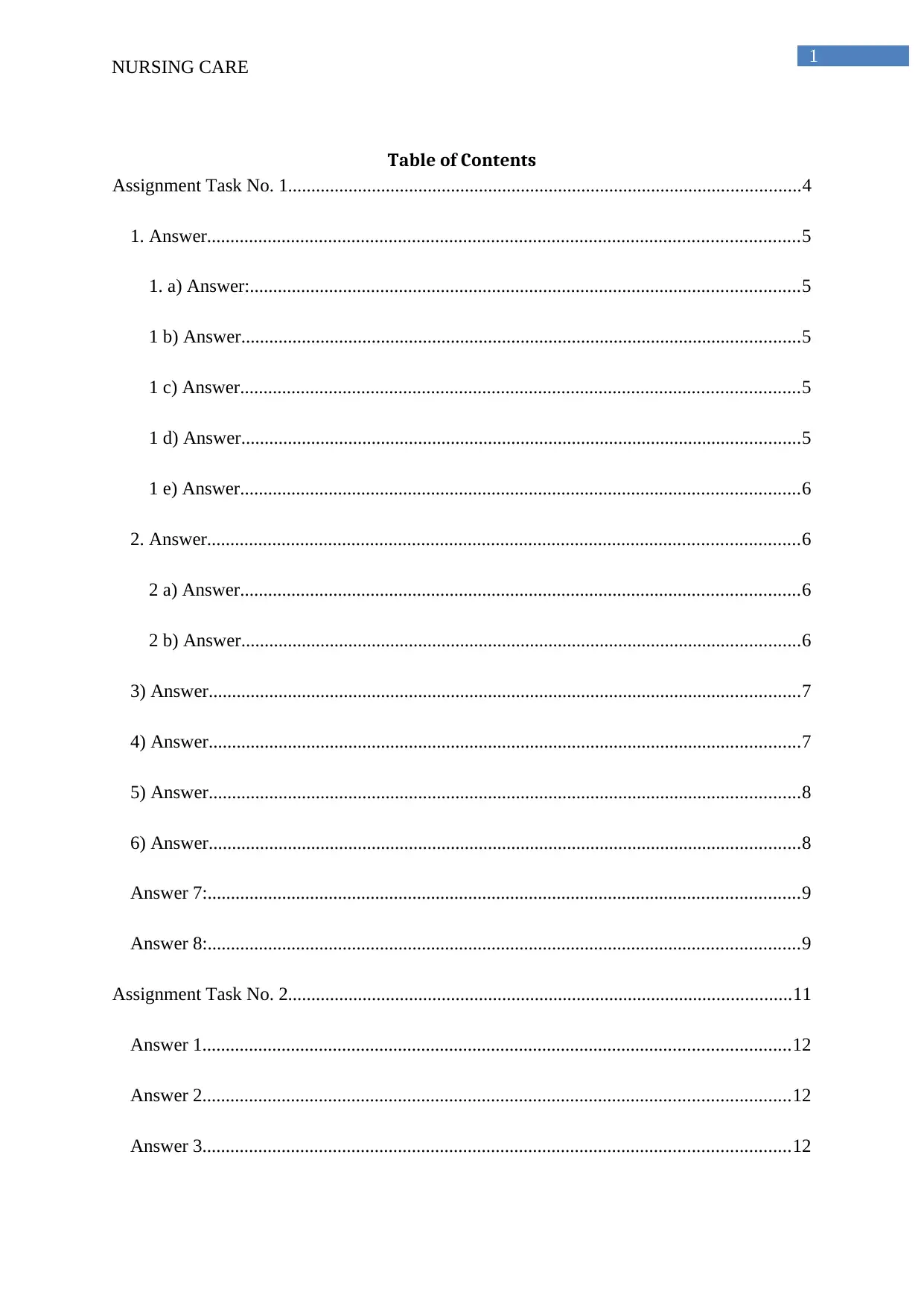
1
NURSING CARE
Table of Contents
Assignment Task No. 1..............................................................................................................4
1. Answer...............................................................................................................................5
1. a) Answer:......................................................................................................................5
1 b) Answer........................................................................................................................5
1 c) Answer........................................................................................................................5
1 d) Answer........................................................................................................................5
1 e) Answer........................................................................................................................6
2. Answer...............................................................................................................................6
2 a) Answer........................................................................................................................6
2 b) Answer........................................................................................................................6
3) Answer...............................................................................................................................7
4) Answer...............................................................................................................................7
5) Answer...............................................................................................................................8
6) Answer...............................................................................................................................8
Answer 7:...............................................................................................................................9
Answer 8:...............................................................................................................................9
Assignment Task No. 2............................................................................................................11
Answer 1..............................................................................................................................12
Answer 2..............................................................................................................................12
Answer 3..............................................................................................................................12
NURSING CARE
Table of Contents
Assignment Task No. 1..............................................................................................................4
1. Answer...............................................................................................................................5
1. a) Answer:......................................................................................................................5
1 b) Answer........................................................................................................................5
1 c) Answer........................................................................................................................5
1 d) Answer........................................................................................................................5
1 e) Answer........................................................................................................................6
2. Answer...............................................................................................................................6
2 a) Answer........................................................................................................................6
2 b) Answer........................................................................................................................6
3) Answer...............................................................................................................................7
4) Answer...............................................................................................................................7
5) Answer...............................................................................................................................8
6) Answer...............................................................................................................................8
Answer 7:...............................................................................................................................9
Answer 8:...............................................................................................................................9
Assignment Task No. 2............................................................................................................11
Answer 1..............................................................................................................................12
Answer 2..............................................................................................................................12
Answer 3..............................................................................................................................12
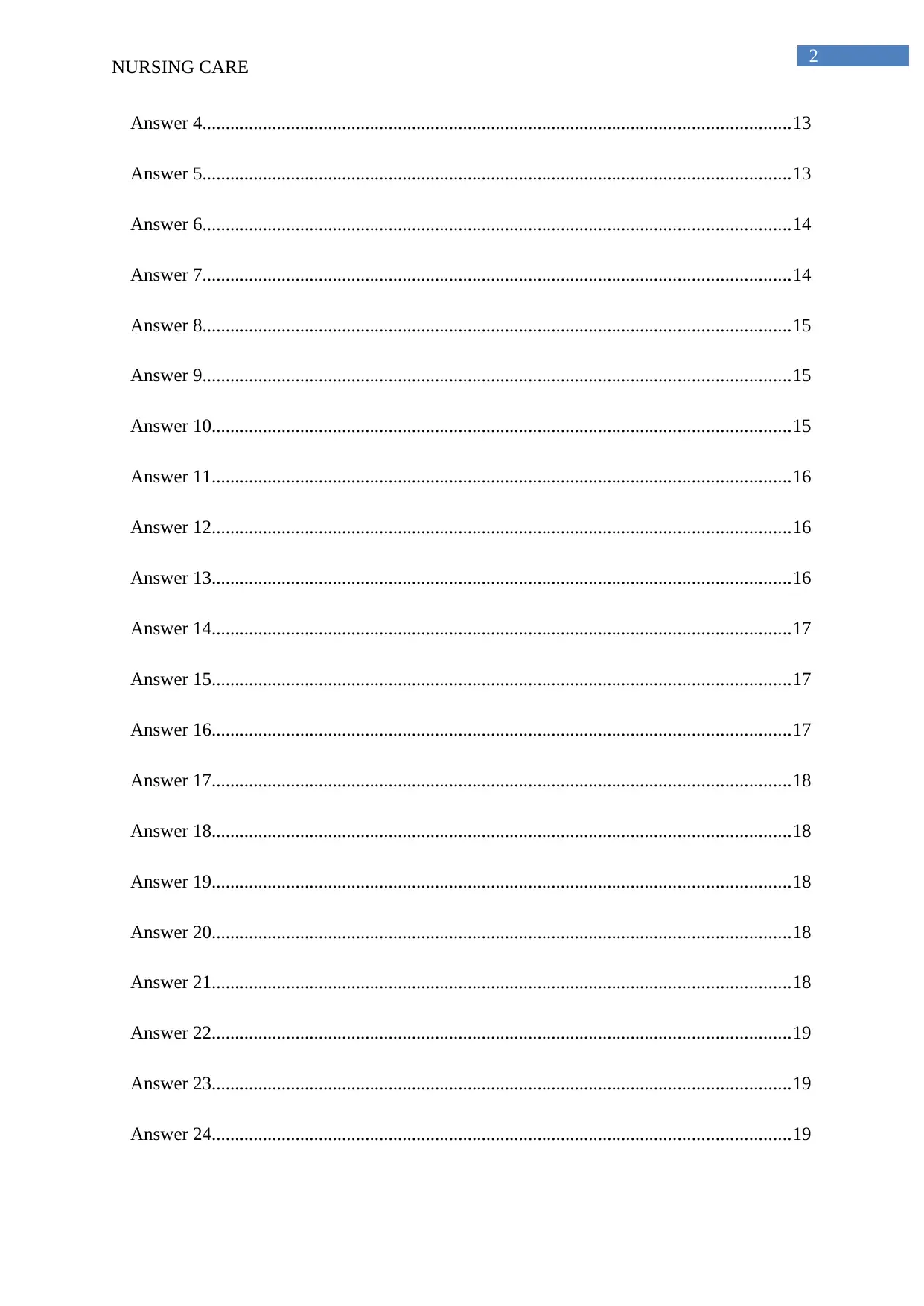
2
NURSING CARE
Answer 4..............................................................................................................................13
Answer 5..............................................................................................................................13
Answer 6..............................................................................................................................14
Answer 7..............................................................................................................................14
Answer 8..............................................................................................................................15
Answer 9..............................................................................................................................15
Answer 10............................................................................................................................15
Answer 11............................................................................................................................16
Answer 12............................................................................................................................16
Answer 13............................................................................................................................16
Answer 14............................................................................................................................17
Answer 15............................................................................................................................17
Answer 16............................................................................................................................17
Answer 17............................................................................................................................18
Answer 18............................................................................................................................18
Answer 19............................................................................................................................18
Answer 20............................................................................................................................18
Answer 21............................................................................................................................18
Answer 22............................................................................................................................19
Answer 23............................................................................................................................19
Answer 24............................................................................................................................19
NURSING CARE
Answer 4..............................................................................................................................13
Answer 5..............................................................................................................................13
Answer 6..............................................................................................................................14
Answer 7..............................................................................................................................14
Answer 8..............................................................................................................................15
Answer 9..............................................................................................................................15
Answer 10............................................................................................................................15
Answer 11............................................................................................................................16
Answer 12............................................................................................................................16
Answer 13............................................................................................................................16
Answer 14............................................................................................................................17
Answer 15............................................................................................................................17
Answer 16............................................................................................................................17
Answer 17............................................................................................................................18
Answer 18............................................................................................................................18
Answer 19............................................................................................................................18
Answer 20............................................................................................................................18
Answer 21............................................................................................................................18
Answer 22............................................................................................................................19
Answer 23............................................................................................................................19
Answer 24............................................................................................................................19
⊘ This is a preview!⊘
Do you want full access?
Subscribe today to unlock all pages.

Trusted by 1+ million students worldwide
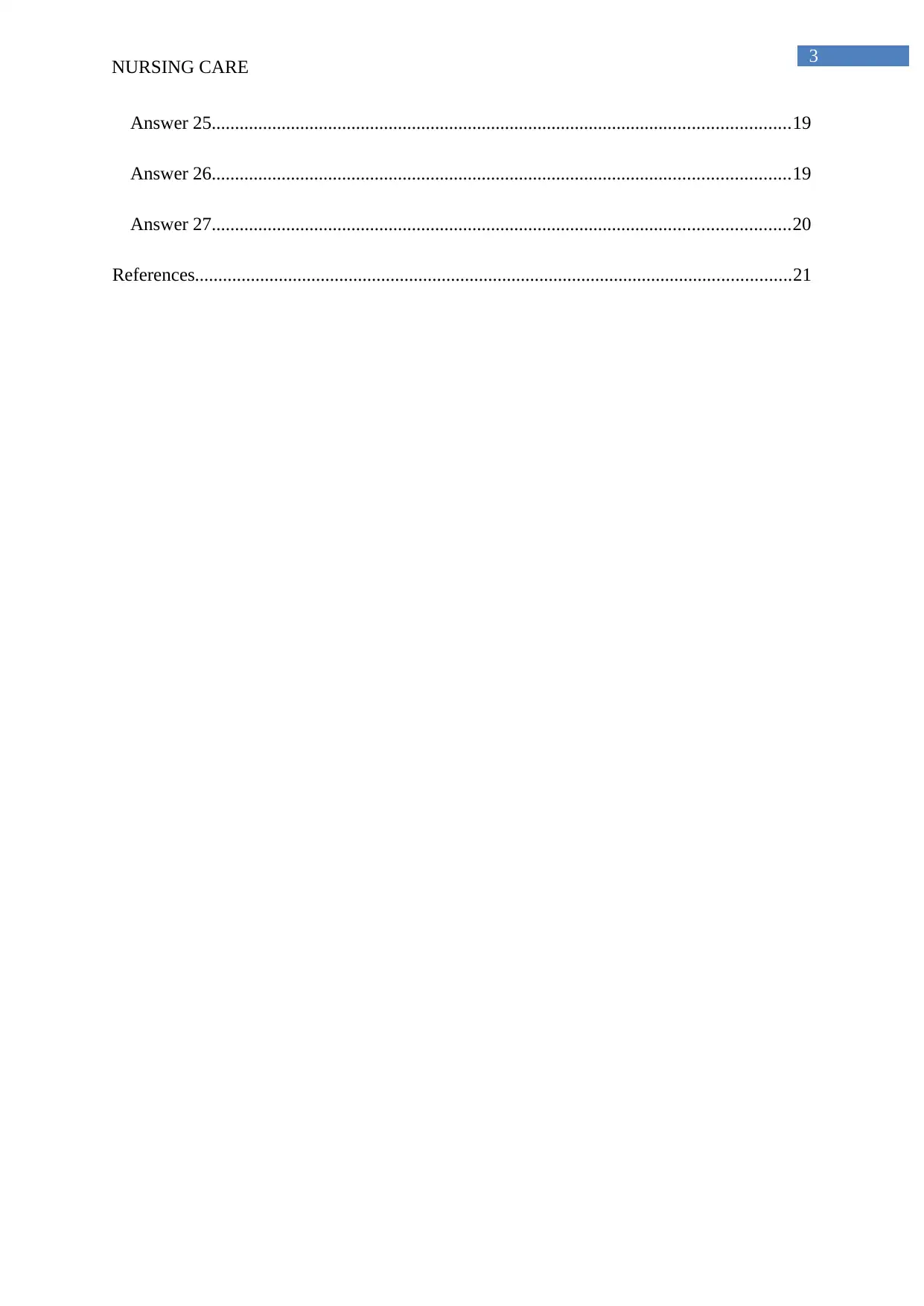
3
NURSING CARE
Answer 25............................................................................................................................19
Answer 26............................................................................................................................19
Answer 27............................................................................................................................20
References................................................................................................................................21
NURSING CARE
Answer 25............................................................................................................................19
Answer 26............................................................................................................................19
Answer 27............................................................................................................................20
References................................................................................................................................21
Paraphrase This Document
Need a fresh take? Get an instant paraphrase of this document with our AI Paraphraser
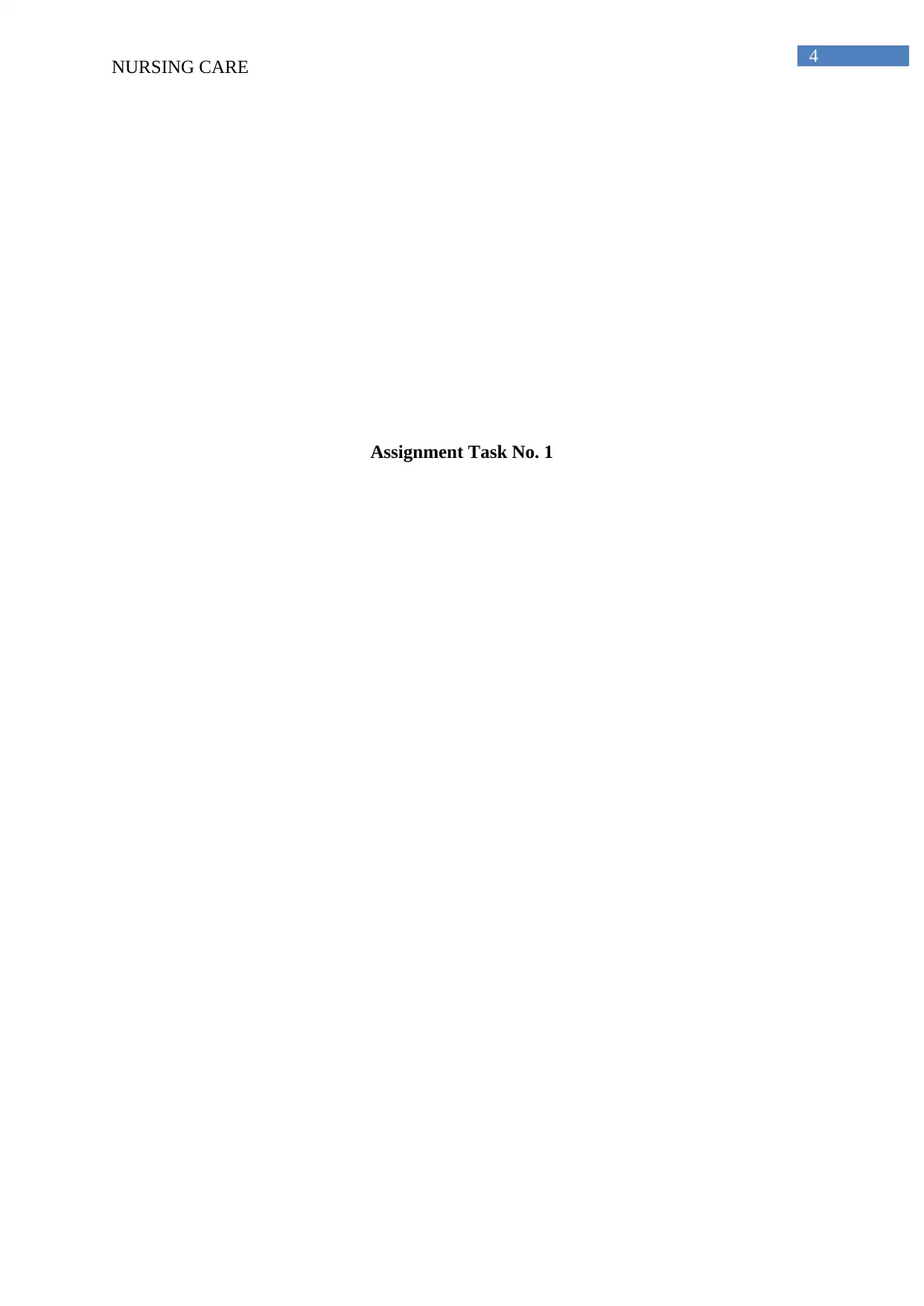
4
NURSING CARE
Assignment Task No. 1
NURSING CARE
Assignment Task No. 1
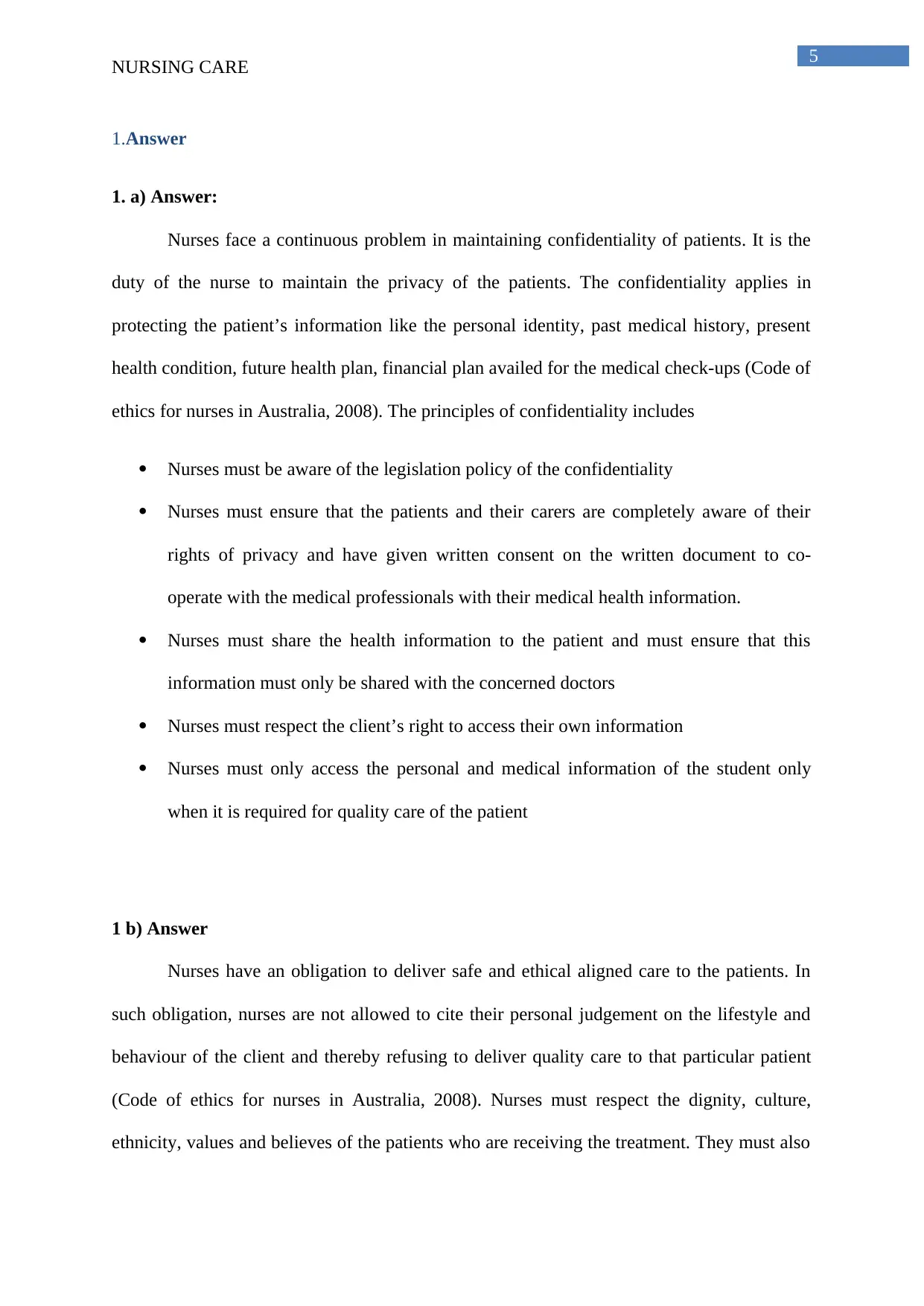
5
NURSING CARE
1.Answer
1. a) Answer:
Nurses face a continuous problem in maintaining confidentiality of patients. It is the
duty of the nurse to maintain the privacy of the patients. The confidentiality applies in
protecting the patient’s information like the personal identity, past medical history, present
health condition, future health plan, financial plan availed for the medical check-ups (Code of
ethics for nurses in Australia, 2008). The principles of confidentiality includes
Nurses must be aware of the legislation policy of the confidentiality
Nurses must ensure that the patients and their carers are completely aware of their
rights of privacy and have given written consent on the written document to co-
operate with the medical professionals with their medical health information.
Nurses must share the health information to the patient and must ensure that this
information must only be shared with the concerned doctors
Nurses must respect the client’s right to access their own information
Nurses must only access the personal and medical information of the student only
when it is required for quality care of the patient
1 b) Answer
Nurses have an obligation to deliver safe and ethical aligned care to the patients. In
such obligation, nurses are not allowed to cite their personal judgement on the lifestyle and
behaviour of the client and thereby refusing to deliver quality care to that particular patient
(Code of ethics for nurses in Australia, 2008). Nurses must respect the dignity, culture,
ethnicity, values and believes of the patients who are receiving the treatment. They must also
NURSING CARE
1.Answer
1. a) Answer:
Nurses face a continuous problem in maintaining confidentiality of patients. It is the
duty of the nurse to maintain the privacy of the patients. The confidentiality applies in
protecting the patient’s information like the personal identity, past medical history, present
health condition, future health plan, financial plan availed for the medical check-ups (Code of
ethics for nurses in Australia, 2008). The principles of confidentiality includes
Nurses must be aware of the legislation policy of the confidentiality
Nurses must ensure that the patients and their carers are completely aware of their
rights of privacy and have given written consent on the written document to co-
operate with the medical professionals with their medical health information.
Nurses must share the health information to the patient and must ensure that this
information must only be shared with the concerned doctors
Nurses must respect the client’s right to access their own information
Nurses must only access the personal and medical information of the student only
when it is required for quality care of the patient
1 b) Answer
Nurses have an obligation to deliver safe and ethical aligned care to the patients. In
such obligation, nurses are not allowed to cite their personal judgement on the lifestyle and
behaviour of the client and thereby refusing to deliver quality care to that particular patient
(Code of ethics for nurses in Australia, 2008). Nurses must respect the dignity, culture,
ethnicity, values and believes of the patients who are receiving the treatment. They must also
⊘ This is a preview!⊘
Do you want full access?
Subscribe today to unlock all pages.

Trusted by 1+ million students worldwide
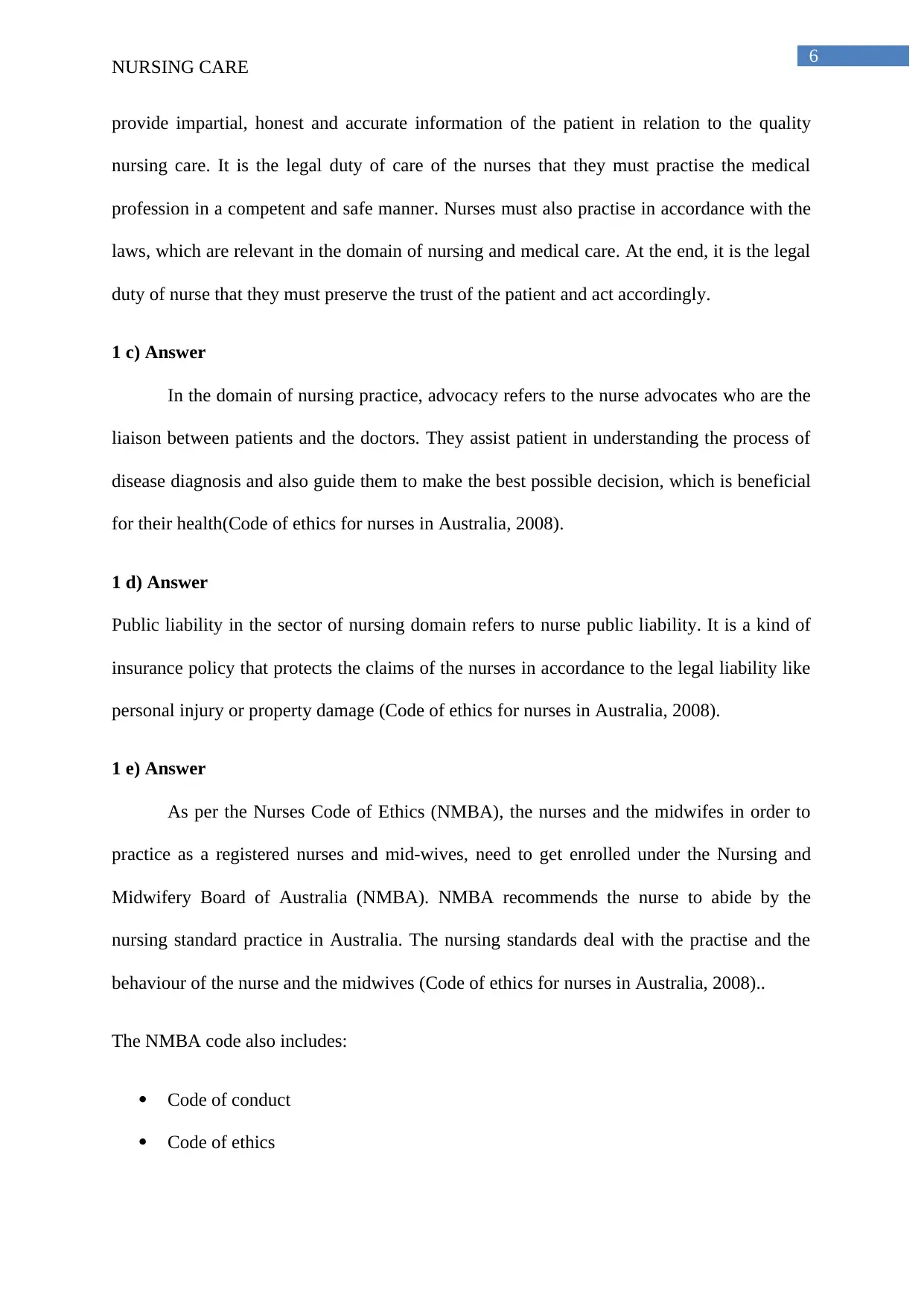
6
NURSING CARE
provide impartial, honest and accurate information of the patient in relation to the quality
nursing care. It is the legal duty of care of the nurses that they must practise the medical
profession in a competent and safe manner. Nurses must also practise in accordance with the
laws, which are relevant in the domain of nursing and medical care. At the end, it is the legal
duty of nurse that they must preserve the trust of the patient and act accordingly.
1 c) Answer
In the domain of nursing practice, advocacy refers to the nurse advocates who are the
liaison between patients and the doctors. They assist patient in understanding the process of
disease diagnosis and also guide them to make the best possible decision, which is beneficial
for their health(Code of ethics for nurses in Australia, 2008).
1 d) Answer
Public liability in the sector of nursing domain refers to nurse public liability. It is a kind of
insurance policy that protects the claims of the nurses in accordance to the legal liability like
personal injury or property damage (Code of ethics for nurses in Australia, 2008).
1 e) Answer
As per the Nurses Code of Ethics (NMBA), the nurses and the midwifes in order to
practice as a registered nurses and mid-wives, need to get enrolled under the Nursing and
Midwifery Board of Australia (NMBA). NMBA recommends the nurse to abide by the
nursing standard practice in Australia. The nursing standards deal with the practise and the
behaviour of the nurse and the midwives (Code of ethics for nurses in Australia, 2008)..
The NMBA code also includes:
Code of conduct
Code of ethics
NURSING CARE
provide impartial, honest and accurate information of the patient in relation to the quality
nursing care. It is the legal duty of care of the nurses that they must practise the medical
profession in a competent and safe manner. Nurses must also practise in accordance with the
laws, which are relevant in the domain of nursing and medical care. At the end, it is the legal
duty of nurse that they must preserve the trust of the patient and act accordingly.
1 c) Answer
In the domain of nursing practice, advocacy refers to the nurse advocates who are the
liaison between patients and the doctors. They assist patient in understanding the process of
disease diagnosis and also guide them to make the best possible decision, which is beneficial
for their health(Code of ethics for nurses in Australia, 2008).
1 d) Answer
Public liability in the sector of nursing domain refers to nurse public liability. It is a kind of
insurance policy that protects the claims of the nurses in accordance to the legal liability like
personal injury or property damage (Code of ethics for nurses in Australia, 2008).
1 e) Answer
As per the Nurses Code of Ethics (NMBA), the nurses and the midwifes in order to
practice as a registered nurses and mid-wives, need to get enrolled under the Nursing and
Midwifery Board of Australia (NMBA). NMBA recommends the nurse to abide by the
nursing standard practice in Australia. The nursing standards deal with the practise and the
behaviour of the nurse and the midwives (Code of ethics for nurses in Australia, 2008)..
The NMBA code also includes:
Code of conduct
Code of ethics
Paraphrase This Document
Need a fresh take? Get an instant paraphrase of this document with our AI Paraphraser
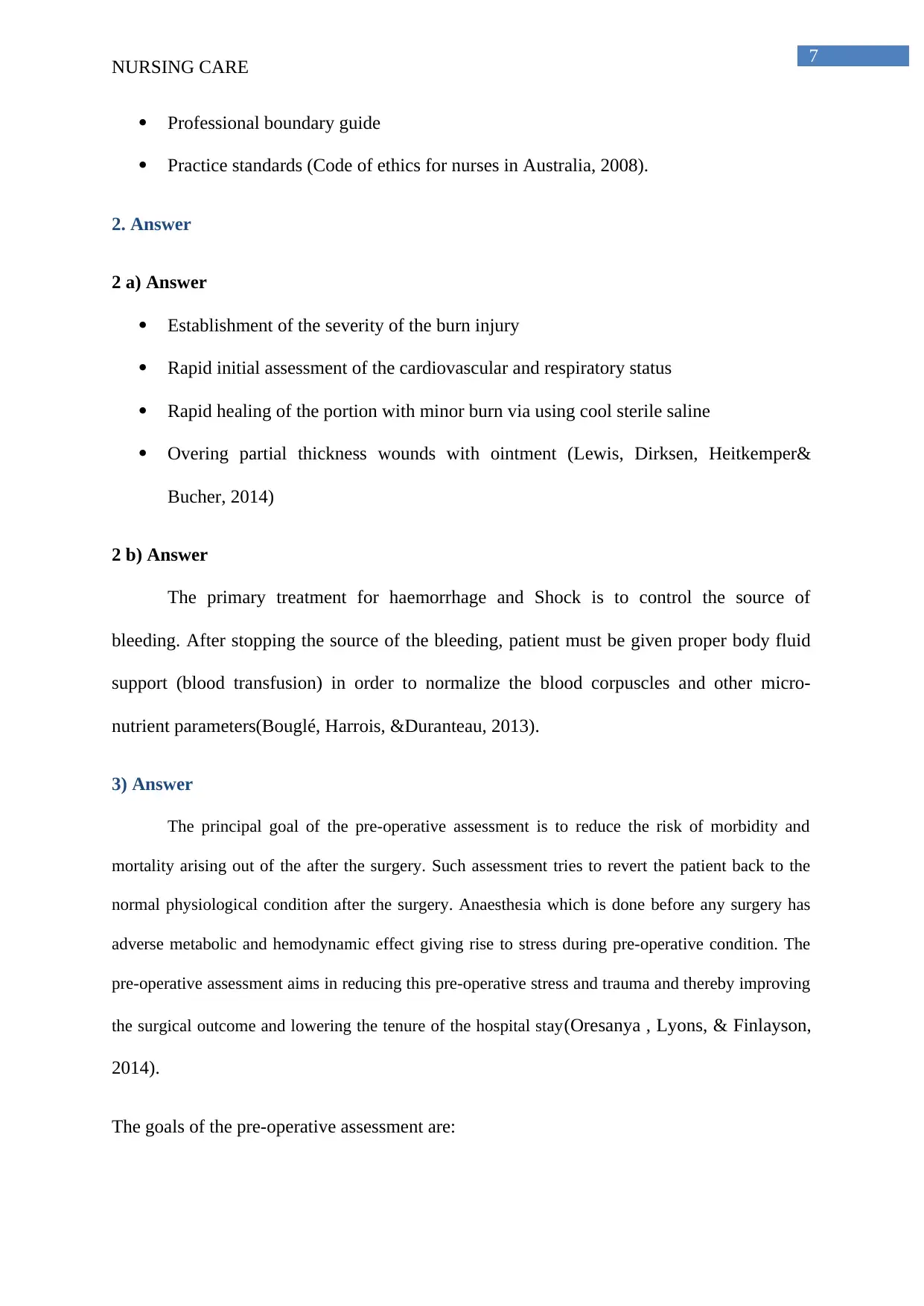
7
NURSING CARE
Professional boundary guide
Practice standards (Code of ethics for nurses in Australia, 2008).
2. Answer
2 a) Answer
Establishment of the severity of the burn injury
Rapid initial assessment of the cardiovascular and respiratory status
Rapid healing of the portion with minor burn via using cool sterile saline
Overing partial thickness wounds with ointment (Lewis, Dirksen, Heitkemper&
Bucher, 2014)
2 b) Answer
The primary treatment for haemorrhage and Shock is to control the source of
bleeding. After stopping the source of the bleeding, patient must be given proper body fluid
support (blood transfusion) in order to normalize the blood corpuscles and other micro-
nutrient parameters(Bouglé, Harrois, &Duranteau, 2013).
3) Answer
The principal goal of the pre-operative assessment is to reduce the risk of morbidity and
mortality arising out of the after the surgery. Such assessment tries to revert the patient back to the
normal physiological condition after the surgery. Anaesthesia which is done before any surgery has
adverse metabolic and hemodynamic effect giving rise to stress during pre-operative condition. The
pre-operative assessment aims in reducing this pre-operative stress and trauma and thereby improving
the surgical outcome and lowering the tenure of the hospital stay(Oresanya , Lyons, & Finlayson,
2014).
The goals of the pre-operative assessment are:
NURSING CARE
Professional boundary guide
Practice standards (Code of ethics for nurses in Australia, 2008).
2. Answer
2 a) Answer
Establishment of the severity of the burn injury
Rapid initial assessment of the cardiovascular and respiratory status
Rapid healing of the portion with minor burn via using cool sterile saline
Overing partial thickness wounds with ointment (Lewis, Dirksen, Heitkemper&
Bucher, 2014)
2 b) Answer
The primary treatment for haemorrhage and Shock is to control the source of
bleeding. After stopping the source of the bleeding, patient must be given proper body fluid
support (blood transfusion) in order to normalize the blood corpuscles and other micro-
nutrient parameters(Bouglé, Harrois, &Duranteau, 2013).
3) Answer
The principal goal of the pre-operative assessment is to reduce the risk of morbidity and
mortality arising out of the after the surgery. Such assessment tries to revert the patient back to the
normal physiological condition after the surgery. Anaesthesia which is done before any surgery has
adverse metabolic and hemodynamic effect giving rise to stress during pre-operative condition. The
pre-operative assessment aims in reducing this pre-operative stress and trauma and thereby improving
the surgical outcome and lowering the tenure of the hospital stay(Oresanya , Lyons, & Finlayson,
2014).
The goals of the pre-operative assessment are:
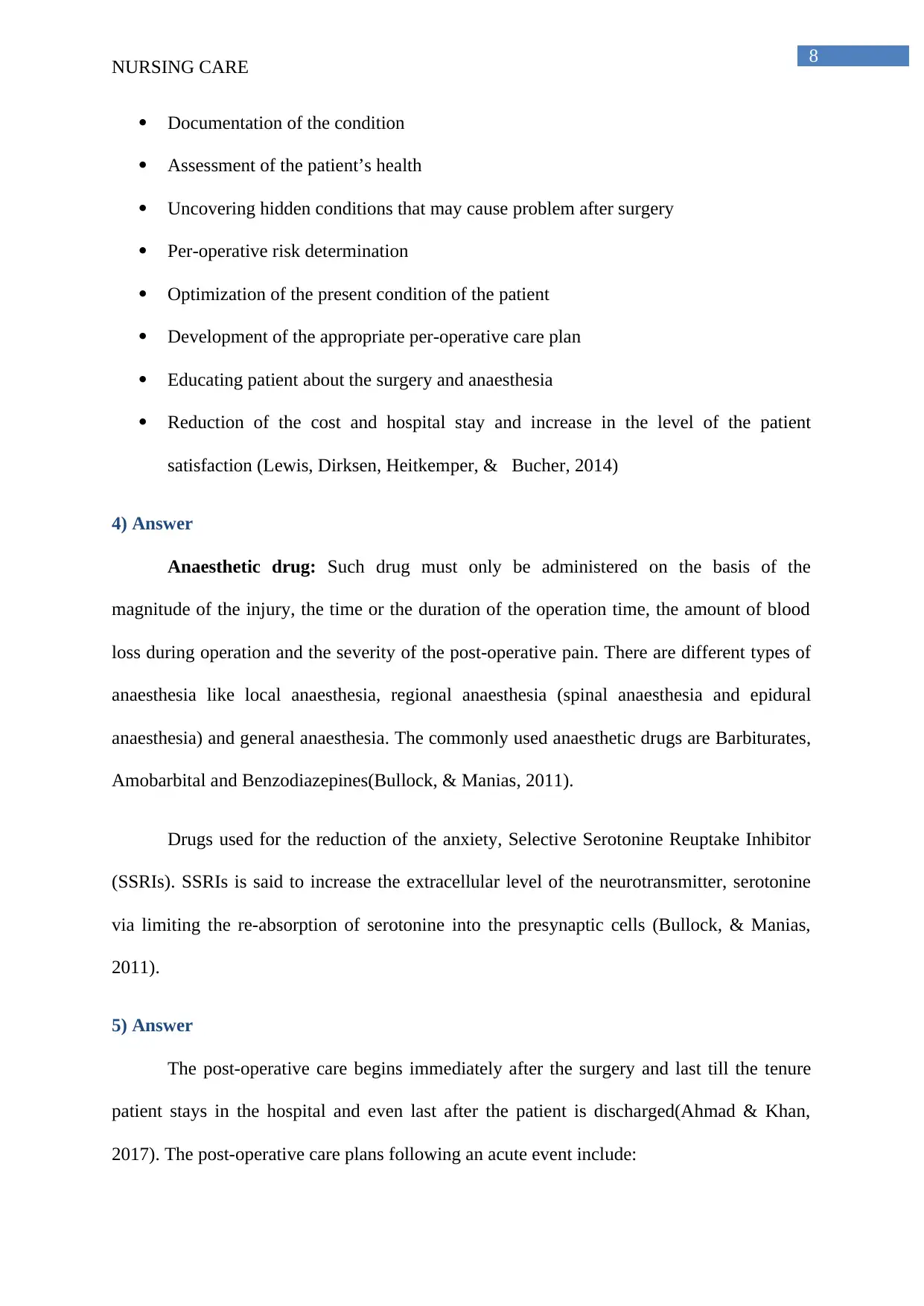
8
NURSING CARE
Documentation of the condition
Assessment of the patient’s health
Uncovering hidden conditions that may cause problem after surgery
Per-operative risk determination
Optimization of the present condition of the patient
Development of the appropriate per-operative care plan
Educating patient about the surgery and anaesthesia
Reduction of the cost and hospital stay and increase in the level of the patient
satisfaction (Lewis, Dirksen, Heitkemper, & Bucher, 2014)
4) Answer
Anaesthetic drug: Such drug must only be administered on the basis of the
magnitude of the injury, the time or the duration of the operation time, the amount of blood
loss during operation and the severity of the post-operative pain. There are different types of
anaesthesia like local anaesthesia, regional anaesthesia (spinal anaesthesia and epidural
anaesthesia) and general anaesthesia. The commonly used anaesthetic drugs are Barbiturates,
Amobarbital and Benzodiazepines(Bullock, & Manias, 2011).
Drugs used for the reduction of the anxiety, Selective Serotonine Reuptake Inhibitor
(SSRIs). SSRIs is said to increase the extracellular level of the neurotransmitter, serotonine
via limiting the re-absorption of serotonine into the presynaptic cells (Bullock, & Manias,
2011).
5) Answer
The post-operative care begins immediately after the surgery and last till the tenure
patient stays in the hospital and even last after the patient is discharged(Ahmad & Khan,
2017). The post-operative care plans following an acute event include:
NURSING CARE
Documentation of the condition
Assessment of the patient’s health
Uncovering hidden conditions that may cause problem after surgery
Per-operative risk determination
Optimization of the present condition of the patient
Development of the appropriate per-operative care plan
Educating patient about the surgery and anaesthesia
Reduction of the cost and hospital stay and increase in the level of the patient
satisfaction (Lewis, Dirksen, Heitkemper, & Bucher, 2014)
4) Answer
Anaesthetic drug: Such drug must only be administered on the basis of the
magnitude of the injury, the time or the duration of the operation time, the amount of blood
loss during operation and the severity of the post-operative pain. There are different types of
anaesthesia like local anaesthesia, regional anaesthesia (spinal anaesthesia and epidural
anaesthesia) and general anaesthesia. The commonly used anaesthetic drugs are Barbiturates,
Amobarbital and Benzodiazepines(Bullock, & Manias, 2011).
Drugs used for the reduction of the anxiety, Selective Serotonine Reuptake Inhibitor
(SSRIs). SSRIs is said to increase the extracellular level of the neurotransmitter, serotonine
via limiting the re-absorption of serotonine into the presynaptic cells (Bullock, & Manias,
2011).
5) Answer
The post-operative care begins immediately after the surgery and last till the tenure
patient stays in the hospital and even last after the patient is discharged(Ahmad & Khan,
2017). The post-operative care plans following an acute event include:
⊘ This is a preview!⊘
Do you want full access?
Subscribe today to unlock all pages.

Trusted by 1+ million students worldwide
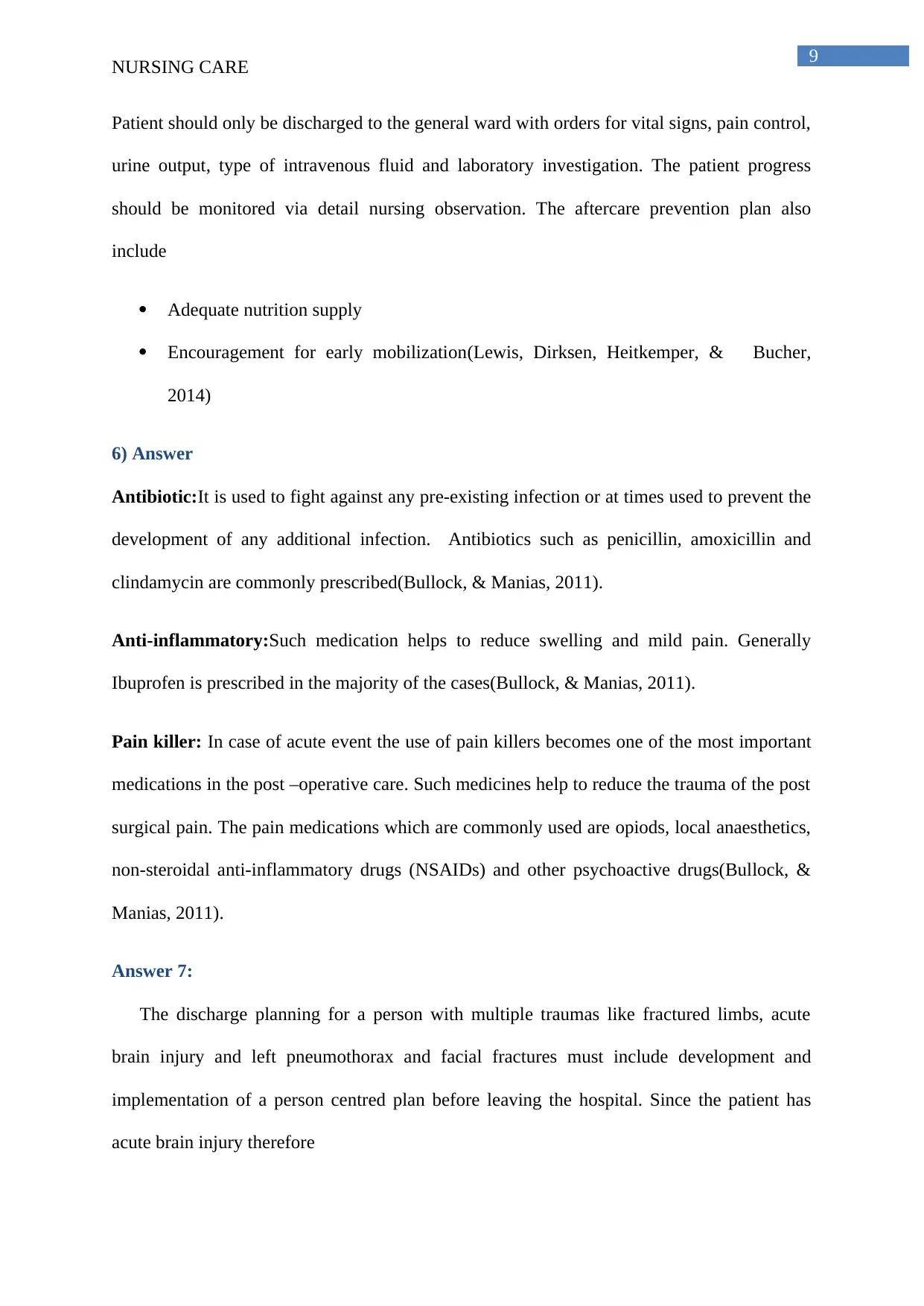
9
NURSING CARE
Patient should only be discharged to the general ward with orders for vital signs, pain control,
urine output, type of intravenous fluid and laboratory investigation. The patient progress
should be monitored via detail nursing observation. The aftercare prevention plan also
include
Adequate nutrition supply
Encouragement for early mobilization(Lewis, Dirksen, Heitkemper, & Bucher,
2014)
6) Answer
Antibiotic:It is used to fight against any pre-existing infection or at times used to prevent the
development of any additional infection. Antibiotics such as penicillin, amoxicillin and
clindamycin are commonly prescribed(Bullock, & Manias, 2011).
Anti-inflammatory:Such medication helps to reduce swelling and mild pain. Generally
Ibuprofen is prescribed in the majority of the cases(Bullock, & Manias, 2011).
Pain killer: In case of acute event the use of pain killers becomes one of the most important
medications in the post –operative care. Such medicines help to reduce the trauma of the post
surgical pain. The pain medications which are commonly used are opiods, local anaesthetics,
non-steroidal anti-inflammatory drugs (NSAIDs) and other psychoactive drugs(Bullock, &
Manias, 2011).
Answer 7:
The discharge planning for a person with multiple traumas like fractured limbs, acute
brain injury and left pneumothorax and facial fractures must include development and
implementation of a person centred plan before leaving the hospital. Since the patient has
acute brain injury therefore
NURSING CARE
Patient should only be discharged to the general ward with orders for vital signs, pain control,
urine output, type of intravenous fluid and laboratory investigation. The patient progress
should be monitored via detail nursing observation. The aftercare prevention plan also
include
Adequate nutrition supply
Encouragement for early mobilization(Lewis, Dirksen, Heitkemper, & Bucher,
2014)
6) Answer
Antibiotic:It is used to fight against any pre-existing infection or at times used to prevent the
development of any additional infection. Antibiotics such as penicillin, amoxicillin and
clindamycin are commonly prescribed(Bullock, & Manias, 2011).
Anti-inflammatory:Such medication helps to reduce swelling and mild pain. Generally
Ibuprofen is prescribed in the majority of the cases(Bullock, & Manias, 2011).
Pain killer: In case of acute event the use of pain killers becomes one of the most important
medications in the post –operative care. Such medicines help to reduce the trauma of the post
surgical pain. The pain medications which are commonly used are opiods, local anaesthetics,
non-steroidal anti-inflammatory drugs (NSAIDs) and other psychoactive drugs(Bullock, &
Manias, 2011).
Answer 7:
The discharge planning for a person with multiple traumas like fractured limbs, acute
brain injury and left pneumothorax and facial fractures must include development and
implementation of a person centred plan before leaving the hospital. Since the patient has
acute brain injury therefore
Paraphrase This Document
Need a fresh take? Get an instant paraphrase of this document with our AI Paraphraser
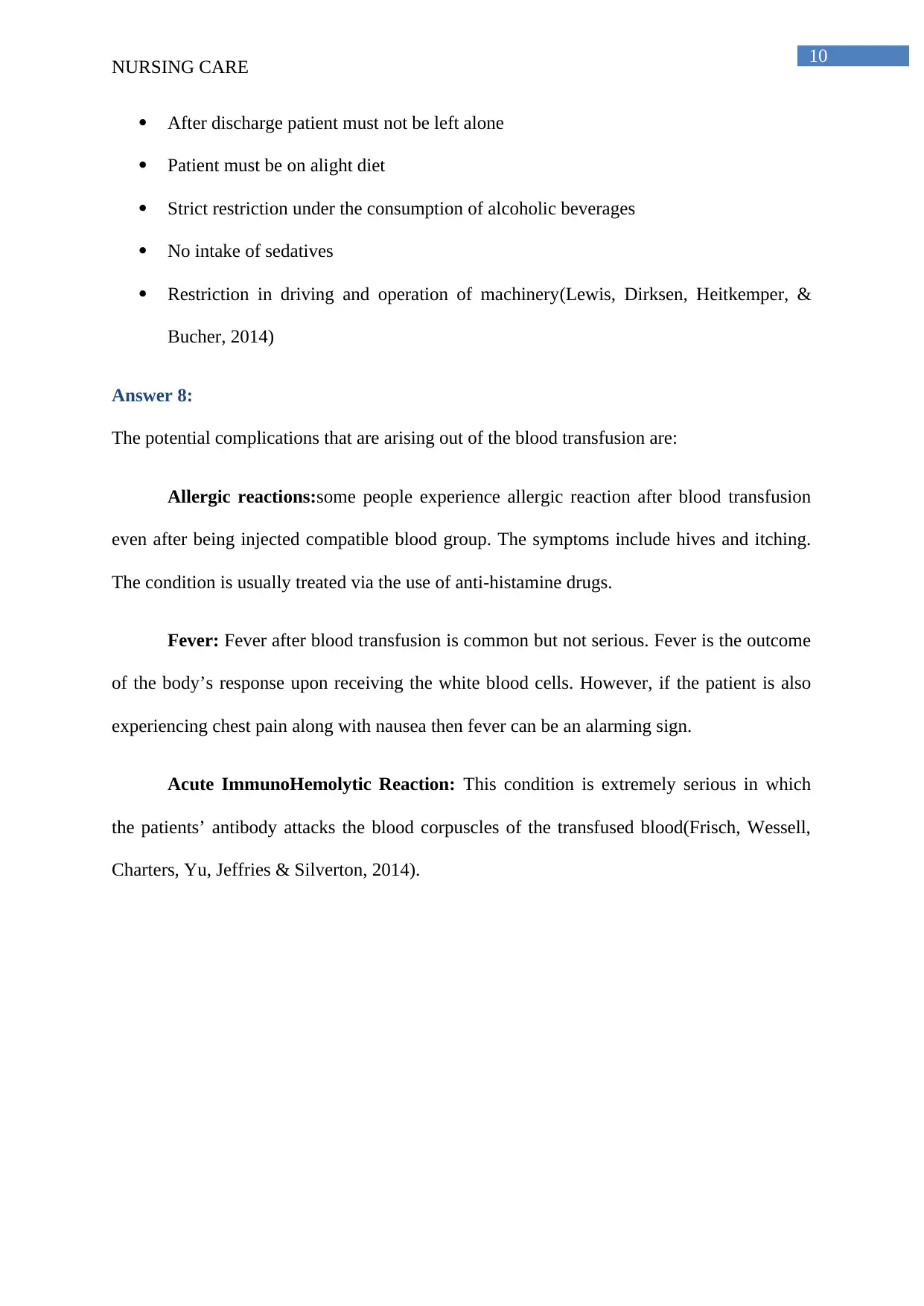
10
NURSING CARE
After discharge patient must not be left alone
Patient must be on alight diet
Strict restriction under the consumption of alcoholic beverages
No intake of sedatives
Restriction in driving and operation of machinery(Lewis, Dirksen, Heitkemper, &
Bucher, 2014)
Answer 8:
The potential complications that are arising out of the blood transfusion are:
Allergic reactions:some people experience allergic reaction after blood transfusion
even after being injected compatible blood group. The symptoms include hives and itching.
The condition is usually treated via the use of anti-histamine drugs.
Fever: Fever after blood transfusion is common but not serious. Fever is the outcome
of the body’s response upon receiving the white blood cells. However, if the patient is also
experiencing chest pain along with nausea then fever can be an alarming sign.
Acute ImmunoHemolytic Reaction: This condition is extremely serious in which
the patients’ antibody attacks the blood corpuscles of the transfused blood(Frisch, Wessell,
Charters, Yu, Jeffries & Silverton, 2014).
NURSING CARE
After discharge patient must not be left alone
Patient must be on alight diet
Strict restriction under the consumption of alcoholic beverages
No intake of sedatives
Restriction in driving and operation of machinery(Lewis, Dirksen, Heitkemper, &
Bucher, 2014)
Answer 8:
The potential complications that are arising out of the blood transfusion are:
Allergic reactions:some people experience allergic reaction after blood transfusion
even after being injected compatible blood group. The symptoms include hives and itching.
The condition is usually treated via the use of anti-histamine drugs.
Fever: Fever after blood transfusion is common but not serious. Fever is the outcome
of the body’s response upon receiving the white blood cells. However, if the patient is also
experiencing chest pain along with nausea then fever can be an alarming sign.
Acute ImmunoHemolytic Reaction: This condition is extremely serious in which
the patients’ antibody attacks the blood corpuscles of the transfused blood(Frisch, Wessell,
Charters, Yu, Jeffries & Silverton, 2014).
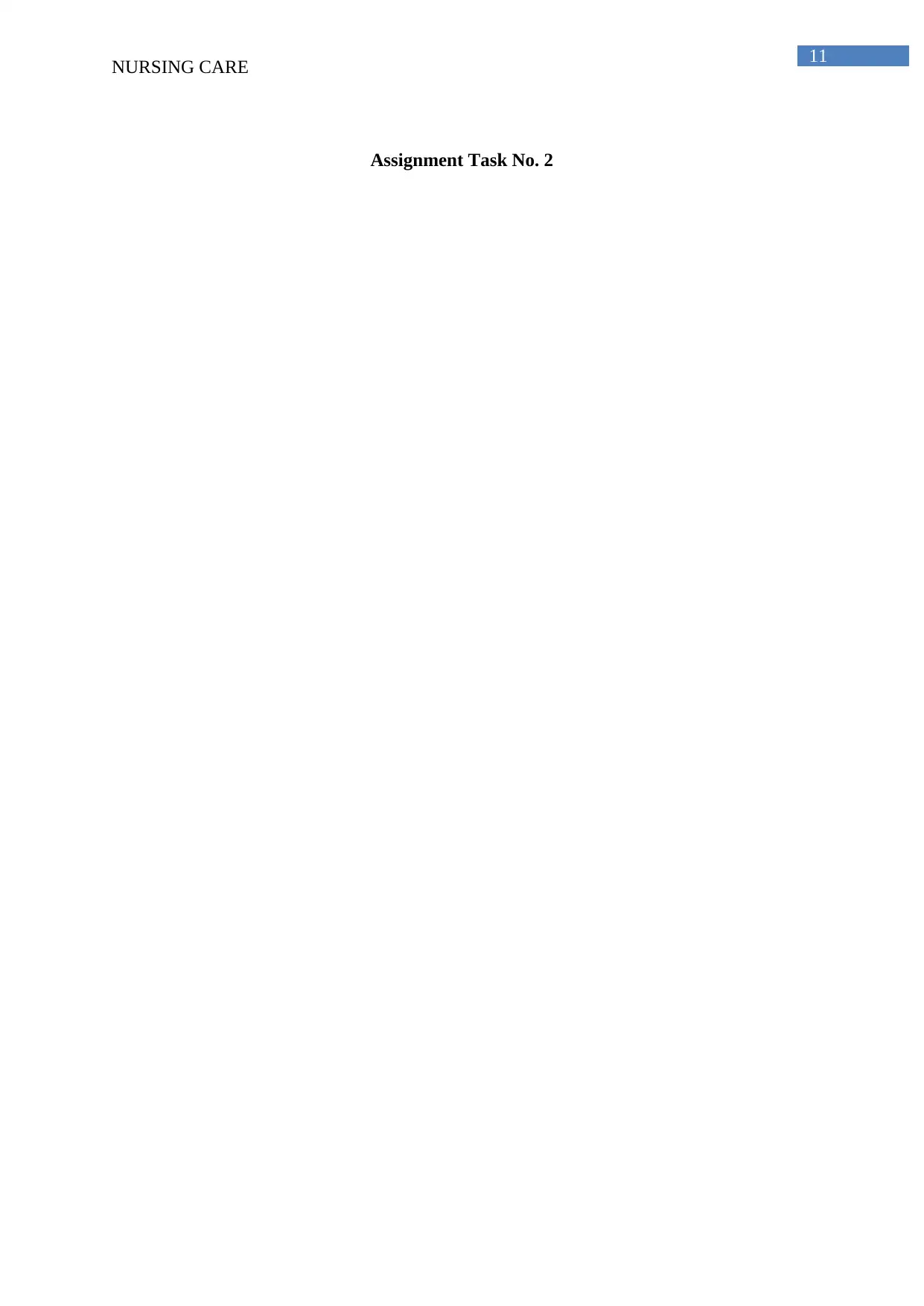
11
NURSING CARE
Assignment Task No. 2
NURSING CARE
Assignment Task No. 2
⊘ This is a preview!⊘
Do you want full access?
Subscribe today to unlock all pages.

Trusted by 1+ million students worldwide
1 out of 24
Related Documents
Your All-in-One AI-Powered Toolkit for Academic Success.
+13062052269
info@desklib.com
Available 24*7 on WhatsApp / Email
![[object Object]](/_next/static/media/star-bottom.7253800d.svg)
Unlock your academic potential
Copyright © 2020–2025 A2Z Services. All Rights Reserved. Developed and managed by ZUCOL.





